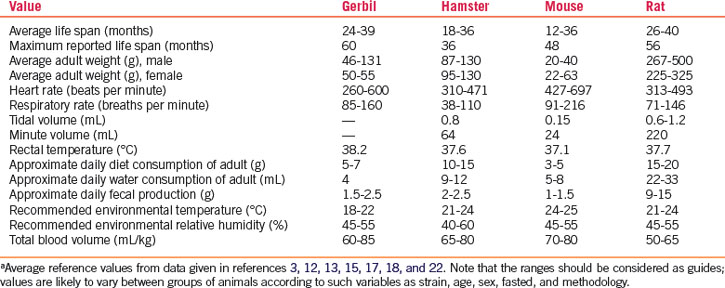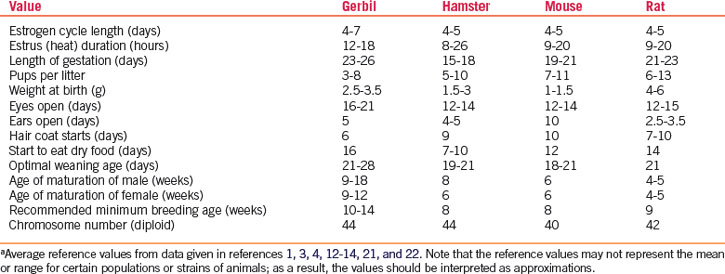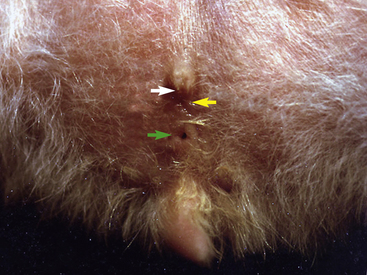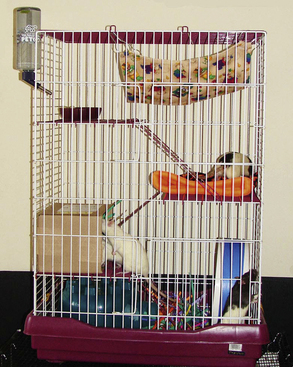Chapter 26 Basic Anatomy, Physiology, Husbandry, and Clinical Techniques
General Characteristics
The hundreds of species belonging to the order Rodentia are grouped into three suborders based on the anatomic and functional differences of the masseter muscle. These three groups are the Caviomorpha (guinea pig-like); the Sciuromorpha (squirrel-like); and the Myomorpha (mouse- or rat-like).20 Although body size varies greatly, in general rodents possess a uniform body structure with various adaptations. While the medical approach to the many small rodents species commonly kept as pets is similar, unusual species are sometimes encountered in practice, and more specific information about these species can be found elsewhere.19
The suborder Myomorpha contains many species of small rodents that appear in the pet trade, including rats, mice, hamsters, and gerbils. Species in this group possess elodont incisors and anelodont cheek teeth.6 The testicles and scrotum are usually large in relation to the overall body size, and the inguinal canal is open, allowing the testicles to pass freely from the abdomen to the scrotum.20 Sciruomorph species such as squirrels and chipmunks are less commonly kep.
Rats
Rats (Rattus norvegicus) are common pets and are considered one of the better rodent pets because of their larger size and calm nature. Rats are most popular in the pet market in hooded color varieties, in which the coat color is present only over the head and shoulders. Rats are generally hardy as young animals but may suffer from obesity, chronic respiratory disease, and mammary tumors when older. Rats are large enough to be easily grasped by children, and they rarely bite. Some may be excitable and run when removed from their cages; however, rats have been known to return to their cages after “escaping.” Rats are social and can live in mixed sex groups, and males may be present while females are raising litters. Introduction of strangers can be performed successfully on neutral territory.20 Rats are relatively intelligent and seem interested in humans; they can be trained to come when called for a treat.
Giant Gambian pouched rats (Cricetomys gambianus), which weigh up to 1.5 kg, are rare in the pet trade. The U.S. Department of Agriculture (USDA) issued a temporary ban on their importation after monkey poxvirus was identified in a group of Gambian rats shipped to the United States in 2003.23 The ban was lifted in 2008. In 2004, the Gambian pouched rat was discovered to have established a breeding population in the Florida Keys. Efforts to control their populations are under way.28
Mice
Standard laboratory mice (Mus musculus) in different color and coat varieties are common as pets. An adult mouse weighs approximately 30 g. Mice make good pets for older children (10 years of age and up) because they rarely bite, but they may move quickly, so younger children may not be able to handle them. Mice are largely nocturnal but are easily roused. Female mice or castrated male mice are recommended over intact males owing to the strong odor of the latter.20 In general, mice are more solitary than other common rodent pets. Female mice usually do well together, but intact males cannot be kept together, as aggression, injury, and death can result. Pet mice are hardy and rarely suffer from infectious disease; however, mite infestations are common and are difficult to treat. Pneumonia and mammary tumors are also frequently seen.
Other less common species, including a variety of African spiny mice (Heteromys species) are kept as pets, but their smaller size makes them more difficult for children to handle. Characterized by their dorsal, inflexible spine-like hairs, spiny mice are likely more closely related to the gerbil.9 In the wild, spiny mice are omnivorous.9
Hamsters
The most common species is the golden or Syrian hamster (Mesocricetus auratus), which comes in a variety of coats, including the long-haired or Teddy Bear breed.20
Gerbils
In nature, gerbils (Meriones unguiculatus) are desert dwellers with efficient kidneys for conserving water.20 Pet gerbils are available in white, black, buff, gray, and spotted varieties. They are extremely active and may be difficult for smaller children to handle; they can slough their tail skin if the tail is caught or grasped too firmly.20 While gerbils are social in nature and live in family groups, they are territorial and often will not tolerate introduction of strangers (cannibalism can result from attempting to keep incompatible pairs or males together). Gerbils are more disease-resistant than hamsters, although older gerbils may develop a variety of neoplastic and degenerative conditions. Epilepsy has been reported in gerbils but is uncommon in many pet strains.
Anatomic and Physiologic Characteristics
General
Rodents are monogastric, with many species having a forestomach that is separated from the glandular stomach by a limiting ridge. They have a relatively large cecum and an elongated colon. Most rodents practice some degree of coprophagy. The ingested fecal pellets presumably provide nutrients, such as B vitamins, produced by the colonic bacteria. Most common rodent species do not vomit, in part because of the limiting ridge in the stomach; but other factors play a role as well, such as the pressure and strength of the esophageal sphincter and crural sling and the innervation of the diaphragm.27,29 For this reason and because these small mammals have such a high metabolic rate, preoperative fasting is not required or recommended.
The urinary and reproductive tracts terminate in separate urethral and vaginal orifices in the female. Small rodents are spontaneous ovulators and are polyestrous. Many breed prolifically in captivity. Stages of the estrous cycle can be determined with vaginal cytology. Mammary tissue can be extensive in rodents and ranges from over the shoulders to the perianal region. Mammary tumors can develop anywhere along this tract. Most female rats and hamsters have 6 pairs of nipples, while gerbils have 4 and mice have 5; however, variations in numbers can be seen.
Normal physiologic, reproductive, and growth reference values are presented in Tables 26-1 and 26-2.
Sexing
Determining the sex of most rodents is easy in mature animals but can be more challenging in very young ones. In general, the distance between the anus and the genital papilla is a reliable method of determining the sex of young animals. The anogenital distance is greater in males than in females, and the genital papilla is usually more prominent and has a round opening in the male. Examining multiple young animals to make a comparison is helpful. The testes of mature males are well developed, especially in rats. Holding the rodent vertically or applying gentle pressure directed caudally on the abdomen allows the testes to pass from the abdomen through the inguinal canal into the scrotum, aiding identification. Female rodents have separate vaginal and urethral orifices, the vaginal orifice being between the urethral orifice and the anus (Fig. 26-1). However, it is difficult to identify the vaginal orifice in immature and very small animals. Grossly observable nipples are seen only on the females of these species. Nipples are observable at 10 days of age in female mice and rat pups.
Husbandry
Housing and Equipment
Suitable enclosures for rodents should be escape-proof and easy to clean. While colorful and interesting, multilevel cages with tubes, wheels, and hide boxes may be so difficult to disassemble that basic cleaning is neglected. Manufacturers recommend that the entire cage be disassembled and washed thoroughly, which in reality is rarely done. Newer multilevel wire cages sit on a plastic base and can be separated to facilitate cleaning (Fig. 26-2). This type of cage provides the additional benefit of separating living space up and away from urine and feces. Features of optimal enclosures are slide-out or easy-to-remove bottoms for ease of cleaning; bottoms with high sides to contain bedding; adequate ventilation (aquariums are not ideal owing to poor ventilation); large doors for easy access to the pet; and a secure locking mechanisms for each cage opening.
Frequent cleaning of the cage is critical in the care of pet rodents. Failure to clean the cage results in the buildup of ammonia and contributes to stress and illness. In mice and rats, Mycoplasma pulmonis organisms multiply more rapidly in the presence of ammonia levels of 50 to 100 ppm.31 The frequency of cage cleaning depends on the cage size and number of animals housed. Advise owners to notice the odor of the bedding; anything other than the scent of clean litter indicates that the cage should be cleaned. Provide food in heavy crocks or food dispensers so that the containers will not be tipped over.
Bedding choices include recycled paper products, corncob products, shredded paper, and shavings of woods such as pine and various hardwoods. Much debate exists on the use hardwood and aromatic shavings such as cedar; anecdotally their use is linked to skin and respiratory disease. Paper bedding is generally preferable, although these products are more expensive than wood shavings. In a study of the endotoxin, dust, and coliform content of 20 types of rodent bedding, endotoxin and coliform levels were lowest in paper bedding, and these products were recommended to reduce the risk of respiratory disease and immune suppression in laboratory rodents.35 In rats, the rate of sneezing and incidence of lung pathology was higher in animals housed on aspen shavings than in those housed on paper bedding.5 However, results of one study in laboratory mice found no difference in growth, food intake, oxygen consumption, IgE antibody concentrations, or general appearance and behavior in male CD-1 mice kept on CareFRESH (Absorption Corp., Ferndale, WA, USA) original bedding, cedar shavings, or pine shavings over a 4-month period.2 In a study evaluating the dermal toxic effects of cedar and juniper on mice and rabbits, concentrations normally found in wood shavings did not elicit any hypersensitivity reaction; reactions were seen only at much higher concentrations (50% or more).10
Stay updated, free articles. Join our Telegram channel

Full access? Get Clinical Tree






